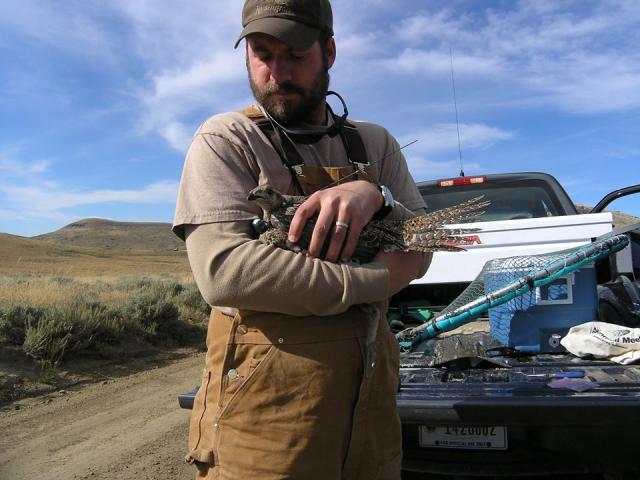Interior Department proposes strengthened protections for greater sage-grouse habitat
Organization:
Media Contact:
WASHINGTON – The Department of the Interior announced today that the Bureau of Land Management (BLM) has published proposed updates to strengthen conservation and management of greater sage-grouse habitat on public lands, informed by the best available science, collaborative work with states, and input from local, Tribal and federal partners. The proposed updates, outlined in a final environmental impact statement and amendments to 77 resource management plans, incorporate new sage-grouse conservation science and lessons learned and accommodate changing resource conditions while increasing implementation flexibility. The proposals balance a consistent west-wide management approach with unique policies in the individual states that are responsible for managing wildlife populations.
Updated habitat management plans will protect greater sage-grouse habitat in 10 Western states. Sage-grouse populations have continued to decline, largely due to habitat loss exacerbated by climate impacts such as drought, increasingly intense wildfires, and invasive species. Conserving sagebrush habitat benefits more than 350 other wildlife species and supports the livelihoods and traditions of Western communities. Species like elk, mule deer, pronghorn and pygmy rabbit rely on the same habitat to survive, and sagebrush lands contain headwaters for some of the West’s major river systems and the aquatic species they sustain.
“Guided by the best available science, we are committed to the continued balance in our multi-use mandate for America’s public lands,” said Secretary Deb Haaland. “For too long, a false choice has been presented for land management that aims to pit development against conservation. This Administration’s collaborative work has demonstrated that we can do both successfully. Through collaborative work in local communities, developed over decades, we are presenting science-based and thoughtful proposals to protect the greater sage-grouse and its habitat.”
The BLM manages the largest single share of greater sage-grouse habitat in the United States—nearly 65 million acres of 145 million total acres. The proposal released today builds on a number of collaborative efforts undertaken by the Biden-Harris administration – including the Public Lands Rule, renewable energy rule, and the proposed Western Solar Plan – to strengthen protection for sagebrush habitat while retaining flexibility to coordinate with state government partners and account for variations in local habitat conditions. Today’s proposal will help ensure that other uses of BLM sagebrush lands, including clean energy projects, move forward in a manner that limits impacts to sensitive resources and can also help combat climate change—a main driver of greater sage-grouse habitat loss.
“This remarkable species and the people who live, work, and play alongside it deserve management that will sustain sagebrush habitat across the West for years to come,” said BLM Director Tracy Stone-Manning. “Our environmental analysis, aided by a wealth of information from our partners, indicates that these proposed updates—which are the result of decades of sustained collaborative efforts—are the best way to ensure the health of these lands and local economies now and into the future.”
The BLM considered roughly 38,000 comments from the public on the draft environmental analysis, along with information shared by state, local, Tribal and federal partners during more than 100 meetings held over two years. States also contributed data and scientific information that helped frame direction on adaptive management and mitigation requirements and supported updates to the boundaries of habitat management areas. The BLM engaged in government-to-government consultation and held informational briefings for Tribal governments throughout the process. Planning documents are available for review at the BLM National NEPA Register.
Protests of the proposed amendments may be filed until Dec. 16, 2024 at the BLM National NEPA Register. Following resolution of valid protests and responses to governors’ reviews for consistency with state and local plans, the BLM will issue Records of Decision for each state where habitat management plans are being updated.
In addition to management decisions guided by the habitat plans, the BLM is actively restoring and conserving sagebrush habitat across the West through the President’s Investing in America agenda. For example, as part of the Department’s new Sagebrush Keystone Initiative, the Department has identified “Sagebrush Collaborative Restoration Landscapes” as areas to collaborate with ranchers, state and local leaders, Tribal Nations, conservation and sportsmen organizations, the outdoor recreation economy, private landowners and others to strategically deliver restoration actions in sagebrush country for the people, wildlife, and economies that depend on them. The Department’s National Seed Strategy Keystone Initiative is also devoting resources to ensure a ready source of native plant seeds to further enhance landscape resilience and has identified five areas of greater sage-grouse range in which to fund habitat restoration and conservation.
The BLM manages more than 245 million acres of public land located primarily in 12 western states, including Alaska, on behalf of the American people. The BLM also administers 700 million acres of sub-surface mineral estate throughout the nation. Our mission is to sustain the health, diversity, and productivity of America’s public lands for the use and enjoyment of present and future generations.

